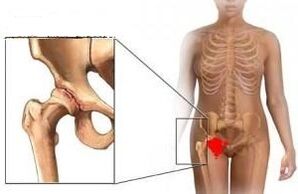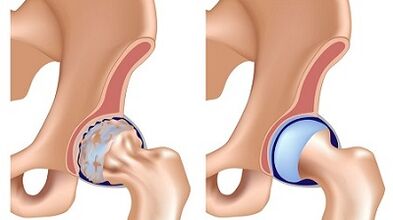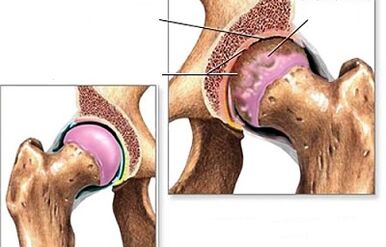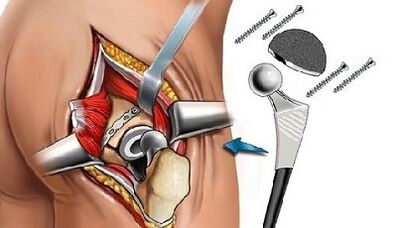
The arthrosis of the hip joint is a serious pathology that develops in the articulation of the hip following nutrition and, due to this, the destruction of the cartilage tissue and the immobility of the thigh.
With a healthy cartilage fabric of the joint, the movement occurs easily and does not cause any inconvenience.If the cartilage is damaged by osteoarthritis, its surface is no longer smooth, it has a bag, pit that makes the flexion/extension of the junction difficult.The thigh becomes like the rusty rings of a garden gate, at the opening of which you feel a crunch and feel tension when you move.
The disease is dangerous as with the premature start of the treatment, the cure is not only impossible, but the course of the disease leads to further immobility and joint loss.
Causes
What is it?Coksartrosis develops for many reasons, the main is a sedentary lifestyle.Very often, athletes suffer from this disorder due to large loads that can hurt the joint.Unfortunately, arthrosis is often inherited, a congenital dislocation in the inguinal region is possible.
The reasons that cause the development of the hip joint joint:
- Disease pearls;
- thigh neck fracture;
- obtain lesions or microtrauma in childhood;
- Excess weight, high load;
- drink alcohol;
- congenital diseases;
- increased levels of hormones (age -related changes);
- Inflammation of the tissues;
- destruction of joint tissues;
- take powerful drugs;
- stressful situations;
- infectious and inflammatory processes;
- Pathological diseases of the thigh in the inguinal region.
Particular attention should be paid to the presence of lesions (microtrauma).They heal for a long time, which leads to the development of the disease for years.Very often, the disease begins to develop in people aged or over 40 years of age.Inflammation begins with an hip joint, but if a timely treatment is not carried out, the disease applies to other areas.
Symptoms of arthrosis of the hip joint

Coksartrosis often develops in people over the age of 40.He progresss gradually and the conditions of a person worsen from year to year.If it is not the damaged articulation, after some time pathological changes can occur in another articulation.
In world practice, it is recognized that the arthrosis of the hip joint has three phases or development phases.Each of them is characterized by its own symptoms.
1 degree of arthrosis of the hip joint
In this phase of the disease, a person experiences pain only with and after physical effort, running or prolonged walk, while mainly the articulation hurts, very rarely pain gives pain to the thigh or knee.
In addition, at the same time, the pace in a person is ordinary, Chroma is not observed, the hip muscles are not atrophied.During the diagnosis of the images, the bone growths are observed, which are found around the internal and external edge of the acetabulum, no other pathological disorders are observed in the neck and head of the femur.
2 degrees of arthrosis of the hip joint
With the arthrosis of the 2nd degree of the hip joint, the symptoms become significant and the pain already acquires a more constant and intense nature, and at rest and when they move, they give both the groin and the thigh, the load, the patient is already limp.There is also a restriction of the thigh, the volume of hip movements is reduced.
In the images, the narrowing of the gap becomes half of the norm, the bone growths are located on the outside and in the inner edge, the head of the hip head begins to increase, deform and move, its edges become irregular.
3 degrees of arthrosis of the hip joint
At this stage of the disease, pain is painful constant of nature, both day and night, the patient becomes difficult to move independently, therefore a barrel or crutch is used, the volume of the joint movement is very limited, the muscles of the lower part of the leg, the hips and the buttocks are atrophy.
The leg is shortened and the person is forced to tilt the body when walking towards the sick leg.From the shift of the center of gravity, the load on the damaged joint increases.In X -ray images, there are more bone growths, the head of the thigh expands and the joint gap is significantly restricted.
Diagnostics
The diagnosis is based on anamnesis data (identification of risk factors or causal diseases), clinical data and additional examination methods.

To clarify the diagnosis and conduct differential diagnostics will help:
- X -raggio of the hip joints;
- Ultrasound of the joints;
- MRI or CT.
As a rule, to establish an accurate diagnosis, a sufficiently clinical and radiological examination.On the radiographs, there are specific changes characteristic of each stage of the disease: narrowing of the joint gap, presence of osteophytes, movement and deformation of the femoral head, subconcreen cysts and periarticular osteosclerosis, osteoporotic changes in the bones.Depending on the presence of these pathological changes and their gravity, the degree and the stage of the disease are established.
Treatment of arthrosis of the hip joint
In the first phase, the arthrosis of the hip joint lends itself perfectly to conservative treatment.The fundamental activity is to relieve pain, which prevents the patient from moving.
In the process of Coxartrosis therapy,:
- restoration of nutrition and blood circulation in muscle and cartilage;
- Physical activity on the damaged joint decreases;
- Restoration of the damaged cartilage;
- Activation of the hidden reserves of the human body, which will contribute to the regeneration of tissues at the microcellular level;
- increase in the joint gap;
- Restoration of the mobility of the joint.
During the pharmacological treatment, this category of patients are prescribed the following drugs:
- Anti -non -seroidal inflammatory.They will help to eliminate pain, to remove the edema and inflammation formed, however, their uncontrolled use will contribute to the suppression of the natural possibility of cartilage to be restored.Doctors do not recommend using more than one non -stericoidal drug simultaneously;
- Relaxing muscles.Remove muscle cramps, increase the flow of blood in the joints, but their use should take place under the supervision of a doctor due to side effects;
- Expanding vases.They are able to relax the muscles smooth and increase the space between the muscles.They have a minimum of contraindications, but their effectiveness is an individual indicator;
- Type of steroids.Help with concomitant diseases such as the presence of inflammation of the thigh bone, but has many side effects;
- Restoration of cartilage.Condroprotectors are the most useful in the treatment for the deformation of arthrosis.They will feed the cartilage with the desired elements and stop the development of the disease;
- Local use.The main positive effect lies in the process of rubbing products in the skin, which relieves muscle cramps and helps improve blood circulation.
During the conservative treatment, patients should adhere to the diet, specially designed for patients with arthrosis of the hip joint.The course of therapeutic therapy includes a therapeutic massage, which is shown to patients with 1 and 2 stages of arthrosis.
Endopropostetic

The third phase of the disease is suitable only for surgical treatment.The patient is recommended to replace the articulation or endopropostetic.The surgeon cuts the head of the thigh bone, inserts a metal pivot into the cut, on which it fits the artificial head.
The prosthesis itself is single -Pole (replacing only the head) and total (to replace both components).The next day after the operation, some elements of the operating therapy are performed in the lying position in bed, the patient can get up, but so far without support on the leg, after a few days with crutches.After 2-3 months, crutches will not be necessary, a complete load on the leg will be allowed.
Patients who have undergone endoprothetic are recommended for rehabilitation, set up in physiotherapy exercises, a massage and physiotherapy course.In most cases, the function of the limb is restored.The service duration of the prosthesis ranges from 10 to 20 years, then is replaced with a new one.
Gymnastics with arthrosis of the hip joint
Coks arthrosis struggle and prevention exercises must be carried out carefully.The movement for operating therapy should be smooth, do not cause pain.LFK for the treatment of the disease should be mainly aimed at strengthening the muscles themselves and not loading the joints.A good way to prevent Coksartrosis is swimming, especially in salted water.
- Starting position: lie on the floor, stretch your arms and legs along the body.Slowly, raise the sore legs straightened in the knee joint 15 cm from the floor and keep it for about half a minute.After that, lower the leg and repeat the exercise with another foot;
- Starting position: lying on the stomach, the legs and arms extend along the body.Lift your legs straight of 15 cm upwards, do and then spread the sides.Everything should be done slowly.
The patient should remember that some exercises with arthrosis of the hip joint from operating therapy can be difficult for him because of his physical training.They are quite effective methods for the prevention of various disorders, therefore, are included in the exercise therapy system both with arthrosis and other diseases.
Popular remedies
In popular medicine, there are many successful methods for the treatment of coxartrosis:

- Tinctures and decoctions used inward (there are many recipes for the preparation of popular curative medicines, which include garlic, lemons, mummy and various parts of plants and honey and so on);
- Ointments based on various natural components (cowardice made ointments, eucalyptus oil, aloe and other plants);
- Compresses and bathtubs (imposition of cabbage sheets, bathrooms with artichoke of Jerusalem and so on).
By applying all popular remedies, it must be remembered that the guarantees of a 100 % recovery do not exist.
Prevention
Prevention measures are very important, especially if you have had a history of dysplasia of the hip joint, fractures, strong bruises or purulent processes in this sector.
- Body weight control (reduce the use of flour products, table salt, sweet tea, strong and coffee in the diet).With overweight, the risk of arthrosis of the hip joint increases.
- Exception of weight transfer, jumps (especially from heights).Try not to stand for a long time.
- If there are diseases associated with metabolism (diabetes, atherosclerosis), they must be compensated.
- Physical exercises dosed aimed at strengthening the muscles of the hips and buttocks (cycling or cycling, swimming, therapeutic gymnastics).
Conformity with preventive measures, the early diagnosis of Coxartrosis and its adequate treatment is the key to a positive prognosis in this disease.
























